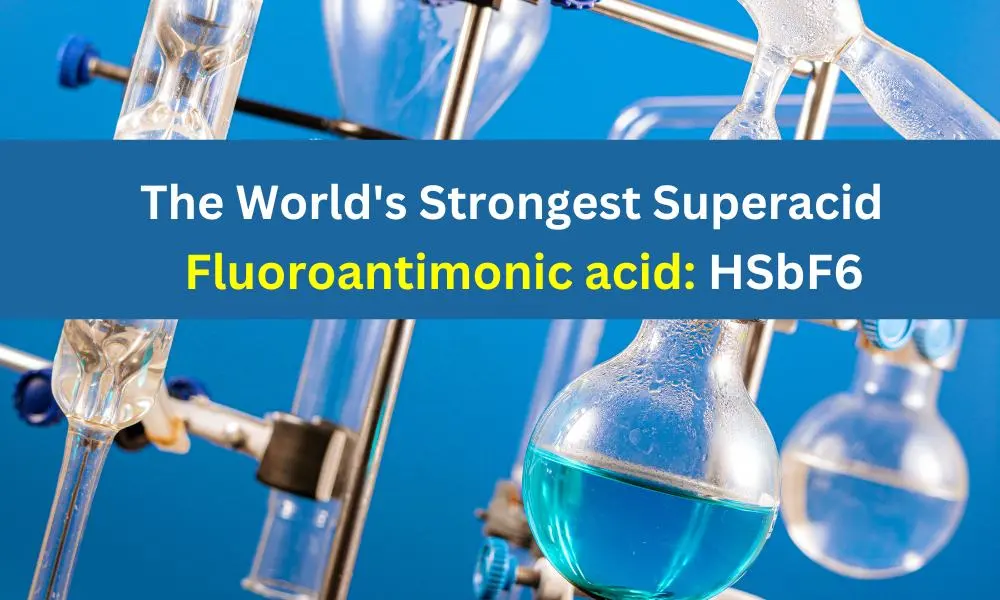Fluoroantimonic acid, known as the “king of superacids,” is a very powerful acid in chemistry. This article will provide an introduction to fluoroantimonic Superacid. We’ll cover World’s Strongest Superacid composition, properties, applications, and tips for safe handling.
What is Fluoroantimonic Acid?
Fluoroantimonic acid, with the chemical formula HSbF6, is a superacid consisting of hydrogen (H), fluorine (F), and antimony (Sb). It is synthesized by mixing two powerful chemicals: hydrofluoric acid (HF) and antimony pentafluoride (SbF5). The resulting compound exhibits remarkable acidity, far surpassing that of traditional acids like sulfuric acid and hydrochloric acid.
Properties of Fluoroantimonic Acid
- Acidity: The world’s Strongest Superacid Fluoroantimonic is renowned for its exceptional acidity, boasting a Hammett acidity function (H0) of -31.3. This acidity level exceeds the theoretical limit for the strength of a Brønsted acid, making fluoroantimonic acid the strongest known superacid.
- Corrosiveness: The potency of the Strongest Superacid extends beyond its acidity; it is highly corrosive and can dissolve various materials, including glass, organic compounds, and even metals such as steel and platinum.
- Reactivity: Due to its extreme acidity, fluoroantimonic acid exhibits high reactivity and can catalyze a wide range of chemical reactions. It is commonly employed as a catalyst in organic synthesis, hydrocarbon cracking, and other industrial processes.
(Read More: Sulphuric Acid Preparation, Properties And Uses In Hindi…)
Uses of Fluoroantimonic Acid
- Chemical Synthesis: Fluoroantimonic acid serves as a versatile catalyst in chemical synthesis, facilitating reactions that would otherwise be challenging or impossible to achieve. It finds applications in the production of pharmaceuticals, agrochemicals, and specialty chemicals.
- Electronics Industry: In the electronics industry, The Strongest Superacid is utilized for etching silicon wafers and manufacturing microchips. Its ability to selectively dissolve silicon dioxide makes it invaluable in the production of integrated circuits and semiconductor devices.
- Research and Development: Scientists and researchers utilize fluoroantimonic acid in laboratory settings to explore the behavior of superacids and study their applications in organic chemistry. Its extreme acidity offers opportunities for innovative research in catalysis, material science, and nanotechnology.
Safety Precautions When Handling Acids
Remember, pure concentrated acids are extremely dangerous and can cause serious harm. Always take safety precautions when handling them. Fluoroantimonic Superacid is extremely strong and reactive, but it’s also very corrosive, which means it can be very harmful.
it also presents significant safety risks due to its corrosive nature:
- Skin and Eye Contact: Direct contact with fluoroantimonic acid can cause severe burns and tissue damage. Protective clothing, gloves, and goggles should be worn when handling this substance.
- Storage and Handling: HSbF6 should be stored in airtight containers made of materials resistant to corrosion, such as polytetrafluoroethylene (PTFE) or Teflon. Proper ventilation and precautionary measures are necessary to prevent accidental exposure and spills.
(Read More: Hydrochloric Acid Preparation, Properties and Uses in Hindi…)
Frequently Asked Questions (FAQs)
1. Why is Fluoroantimonic Acid So Strong?
Fluoroantimonic acid is incredibly strong because of its unique chemical structure. It contains a combination of hydrogen, fluorine, and antimony, which forms a super-acidic solution. The presence of fluorine atoms makes it highly electronegative, while antimony adds to its acidity. This combination results in a superacid with unmatched strength, surpassing all other known acids in terms of acidity.
2. What Happens if You Touch Fluoroantimonic Acid?
Touching Strongest acid can result in severe chemical burns and tissue damage. It is highly corrosive and can cause immediate and severe harm upon contact with the skin or eyes. Protective gear, including gloves and goggles, should always be worn when handling this substance to prevent accidents and injuries.
3. How Strong is Fluoroantimonic Acid?
HSbF6 is recognized as the strongest known superacid, boasting a Hammett acidity function (H0) of -31.3. This acidity level exceeds the theoretical limit for the strength of a Bronsted acid, making HSbF6 unparalleled in its acidity and reactivity.
4. Can Fluoroantimonic Acid Kill You?
While fluoroantimonic acid is incredibly potent and can cause severe burns and injuries upon contact, it is not typically lethal if handled properly. However, exposure to fluoroantimonic superacid can result in serious health complications and should be avoided at all costs. It is essential to follow strict safety protocols and handle this substance with extreme caution to prevent accidents and ensure personal safety.
Conclusion:
Fluoroantimonic acid stands as a testament to the remarkable capabilities of modern chemistry, offering unparalleled acidity and reactivity that open doors to new frontiers in research and industrial applications. However, its potency demands respect and careful handling to ensure safety and prevent accidents. Understanding the properties, uses, and safety considerations of Strongest acid is crucial for scientists, engineers, and industries seeking to harness its power while minimizing risks. As we continue to explore the possibilities of this remarkable substance, it remains a cornerstone of innovation and discovery in the field of chemistry.
